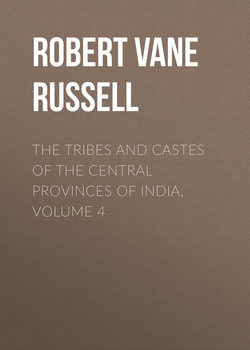Читать книгу The Tribes and Castes of the Central Provinces of India, Volume 4 - Robert Vane Russell - Страница 124
Part II
Articles on Castes and Tribes
Kumhār—Yemkala
Vol. IV
Mahli
Оглавление1. Origin of the caste
Mahli, Mahili.140—A small caste of labourers, palanquin-bearers and workers in bamboo belonging to Chota Nāgpur. In 1911 about 300 Mahlis were returned from the Feudatory States in this tract. They are divided into five subcastes: the Bānsphor-Mahli, who make baskets and do all kinds of bamboo-work; the Pāhar-Mahli, basket-makers and cultivators; the Sulunkhi, cultivators and labourers; the Tānti who carry litters; and the Mahli-Munda, who belong to Lohardaga. Sir H. Risley states that a comparison of the totemistic sections of the Mahlis given in the Appendix to his Tribes and Castes with those of the Santāls seems to warrant the conjecture that the main body of the caste are merely a branch of the Santāls. Four or five septs, Hansda a wild goose, Hemron, Murmu the nilgai, Saren or Sarihin, and perhaps Tudu or Turu are common to the two tribes. The Mahlis are also closely connected with the Mundas. Seven septs of the main body of the Mahlis, Dumriār the wild fig, Gundli a kind of grain, Kerketa a bird, Mahukal a bird (long-tail), Tirki, Tunduār and Turu are also Munda septs; and the three septs given of the Mahli-Munda subcaste, Bhuktuār, Lāng Chenre, and Sānga are all found among the Mundas; while four septs, Hansda a wild goose, Induār a kind of eel, as well as Kerketa and Tirki, already mentioned, are common to the Mahlis and Turis who are also recognised by Sir H. Risley as an offshoot of the Munda tribe with the same occupation as the Mahlis, of making baskets.141 The Santāls and Mundas were no doubt originally one tribe, and it seems that the Mahlis are derived from both of them, and have become a separate caste owing to their having settled in villages more or less of the open country, and worked as labourers, palanquin-bearers and bamboo-workers much in the same manner as the Turis. Probably they work for hire for Hindus, and hence their status may have fallen lower than that of the parent tribe, who remained in their own villages in the jungles. Colonel Dalton notes142 that the gipsy Berias use Mānjhi and Mahali as titles, and it is possible that some of the Mahlis may have joined the Beria community.
2. Social customs
Only a very few points from Sir H. Risley’s account of the caste need be recorded here, and for further details the reader may be referred to his article in the Tribes and Castes of Bengal. A bride-price of Rs. 5 is customary, but it varies according to the means of the parties. On the wedding day, before the usual procession starts to escort the bridegroom to the bride’s house, he is formally married to a mango tree, while the bride goes through the same ceremony with a mahua. At the entrance to the bride’s house the bridegroom, riding on the shoulders of some male relation and bearing on his head a vessel of water, is received by the bride’s brother, equipped in similar fashion, and the two cavaliers sprinkle one another with water. At the wedding the bridegroom touches the bride’s forehead five times with vermilion and presents her with an iron armlet. The remarriage of widows and divorce are permitted. When a man divorces his wife he gives her a rupee and takes away the iron armlet which was given her at her wedding. The Mahlis will admit members of any higher caste into the community. The candidate for admission must pay a small sum to the caste headman, and give a feast to the Mahlis of the neighbourhood, at which he must eat a little of the leavings of food left by each guest on his leaf-plate. After this humiliating rite he could not, of course, be taken back into his own caste, and is bound to remain a Mahli.
140
This article consists of extracts from Sir H. Risley’s account of the caste in the Tribes and Castes of Bengal.
141
See lists of exogamous septs of Mahli, Sandāl, Munda and Puri in Appendix to Tribes and Castes cf Bengal.
142
Ethnology of Bengal, p. 326.
